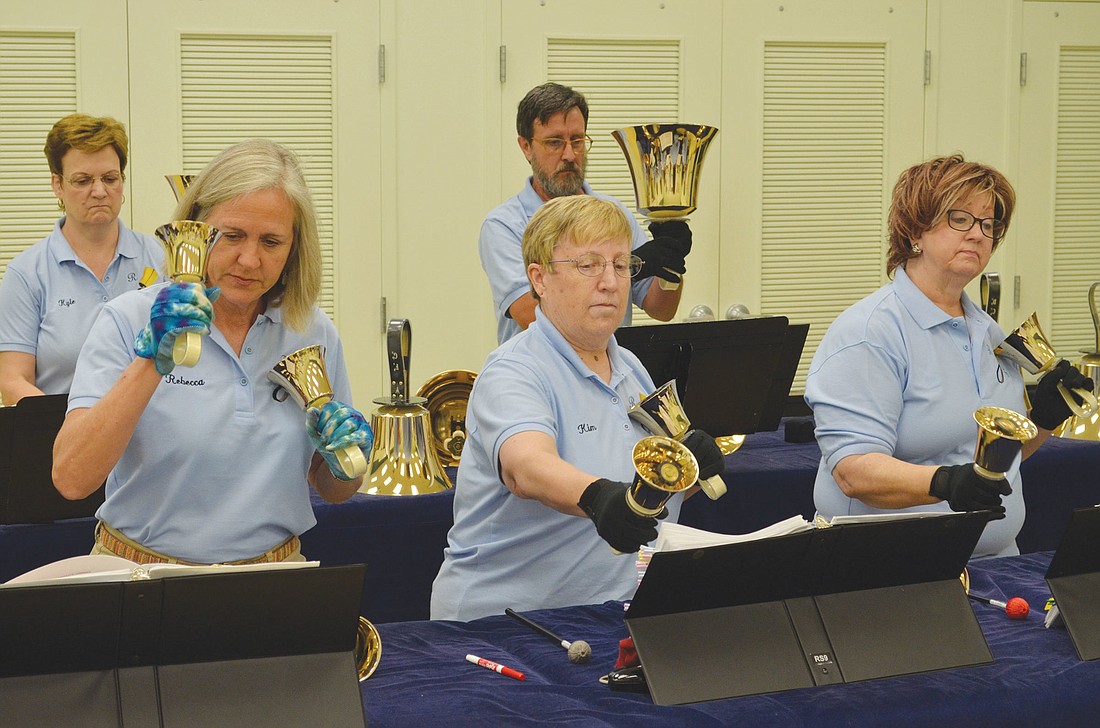- April 25, 2024
-
-
Loading

Loading

Learning to read music is as complex as learning another language. The most intimidating hurdle for beginners often is learning all the notes: seven traditional pitches, not including the various sharps and flats on the musical scale.
But what if there was an instrument that required you to play only one note? That’s the arrangement when it comes to handbell choir. Each musician is assigned a note (or series of notes) on the staff.
But in a choir with more than a dozen members playing an armada of bells in a five-octave set, one note isn’t insignificant. One note is everything.
“The whole choir becomes one instrument,” says Kim Johnson, a third-year choir member of Ring Sarasota. “And it’s not like the violin or the piano where you have all the notes to play. You usually have two notes to play, and to make this instrument work, the bells need to be in my hand and struck at the proper time or you no longer have a melody line.”
Ring Sarasota is a 15-member handbell choir that practices for two hours every Monday, at Pine Shores Presbyterian Church. Formed by director Rick Holdsworth in 2010, the choir’s members play diverse instruments such as piano, euphonium, trombone, flute, flugelhorn, organ and timpani.
“Five years ago I had an idea to take the best ringers in the area and take them out of their church groups and make a band,” says Holdsworth, who also is the director of music at Pine Shores Presbyterian. “We have members who commute from New Port Richey, St. Petersburg and Englewood. If you travel 90 miles every week, you’re loyal and dedicated.”
Ring Sarasota’s latest season included an array of pop, rock and religious songs, including “Rock Around the Clock,” “Ragtime,” “Good Vibrations,” “The Muppet Show Theme,” “The Addams Family Theme,” a John Williams medley and more spiritual fare such as “Gaudeamus,” “Meditation on Beautiful Savior” and “Eternal Father, Strong to Save.”
The choir’s five-octave handbell set (made possible by a $25,000 donation after the choir’s first season) includes 61 bells ranging from tiny bells producing piercing high notes to 8-pound, bucket-sized bells that emit deep tones. When choir members shake their assigned bells or hit them with felt mallets with choreographic precision, the tones emanating from the bells are not only an aural experience but also a physical one. Vibrations and sounds from the bells reverberate throughout the body.
Choir members say that they have one underlying mission: persuading people to take handbells seriously.
“...the key is getting out in the community and showing our love for music and showing that hand bells are more than churches and Christmastime,” says Holdsworth. “We want handbells to be in the mainstream.”
Bell’s Anatomy
Bell: The exterior and polished casting is made of a combination of bronze, tin and copper in a particular size and density to produce a specific note.
Clapper: The tongue inside the bell that collides with the metal casting, producing the instrument’s specific note.
Handle: Ringers often hold the handle with gloves to avoid blisters or dropping the bell. The handle lists the musical note range of the bell and must be held and played with the flick of the wrist to produce a quality and resonate note.